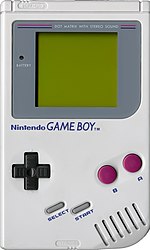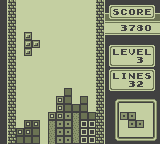Game Boy
 | |
| Manufacturer | Nintendo |
|---|---|
| Type | Handheld game console |
| Generation | Third generation |
| Lifespan | JP April 21, 1989 NA August 1989 EU 1990 |
| Units sold | Worldwide: 118.69 million, as of March 31 2005 (includes Game Boy Color) Japan: 32.47 million Americas: 44.06 million Other: 42.16 million[1][2] |
| Media | Game Boy cartridges |
| Best-selling game | Tetris, 33 million (pack-in / separately)[3] Pokémon Red, Blue, and Green, 20.08 million approximately (details)[4][5] |
| Predecessor | Game & Watch |
| Successor | Game Boy Pocket |
The Game Boy (ゲームボーイ, Gēmu Bōi) is a handheld game console developed and manufactured by Nintendo, released in 1989 at US$89.95.[6][7] The Game Boy was the first successful handheld console, and was the predecessor of all other iterations of the Game Boy line.
The Game Boy was originally bundled with the puzzle game Tetris,[6] since Nintendo thought that an addictive puzzle game would get consumers' attention.[verification needed]
Features
Technical information
- CPU: Custom 8-bit Sharp x80 core at 4.19 MHz which is similar to an Intel8080 in that all of the registers introduced in the Z80 are not present. However, some of the instruction set enhancements from the Z80, particularly bit manipulation are present. Still other instructions are unique to this particular flavor of x80 CPU. The core also contains integrated sound generation
- RAM: 8 kByte internal S-RAM
- Video RAM: 8 kByte internal
- ROM: On-CPU-Die 256-byte bootstrap; 256 kbit, 512 kbit, 1 Mbit, 2 Mbit and 4 Mbit and 8 Mbit cartridges
- Sound: 2 Square Waves, 1 programmable 32-sample 4-bit PCM Wave, 1 White noise. The unit only has one speaker, but headphones provide stereo sound
- Display: Reflective LCD 160 × 144 pixels
- Screen size: 66 mm (2.6 in) diagonal
- Color Palette: 4 shades of "gray" (green to (very) dark green)
- Communication: Up to 2 Game Boys can be linked together via serial ports
- Power: 6 V, 0.7 W (4 AA batteries provide ~#35 hours)
- Dimensions: 90mm(W) × 148mm(H) × 32mm(D)/3.5 × 5.8 × 1.3 (inch)
Controls
The Game Boy's main controls are located on the lower half of its front frame.
Like the NES controller, the Game Boy has four face buttons labelled "A", "B", "SELECT", and "START". The functions of these face buttons vary from game to game, though generally, the START button is used as a "pause" function to temporarily stop gameplay. The Game Boy also features a directional pad, allowing up to eight directions of movement in its games.
Outside of buttons used in gameplay, there is a volume control knob on the right side of the console, and a similar knob to change the contrast on the left side. The ON/OFF switch is located at the top of the Game Boy.[8]
Input/output

The Game Boy contains the following input/output connectors:
- A power input, located on the left side of the handheld console. The power adapter was included in a rechargeable battery pack kit. Separate editions of the battery pack were made for 110V and 230V countries. The Game Boy requires 6V DC of at least 250mA.[8]
- A link cable port, located on the right side. It connects multiple Game Boy handheld consoles, and transfers information between two or more games of the same type or same series. This was widely used in games such as Pokémon. The port can also be used to connect a Game Boy Printer
- A 3.5mm stereo headphone jack output is located on the bottom side of the console.
- An input for Game Boy cartridges (also called Game Paks) is situated on top of the Game Boy.
Games

One of the top-selling games for the Game Boy was Tetris, which sold about 30 million copies in the US,[9] and is an example of a killer game. Tetris was packaged with the Game Boy and, often, consumers were buying the Game Boy to play Tetris.[10]
The last game released and marketed for the original Game Boy was Pokémon Yellow in 1999,[citation needed] although numerous games released over the next few years for its successor, the Game Boy Color, would also be playable on the system.
Sales and competition
As of March 31 2005, the Game Boy and Game Boy Color combined have sold 118.69 million units worldwide.[1][2] The Game Boy line has become the quintessential handheld gaming system, and until the recent Nintendo DS, was by far the most popular one on the market.
At the time of its release in 1989, the Atari Lynx, was also just being introduced to the market. This system featured color graphics, a backlit screen, and networking capabilities.[11] Nevertheless, its release price of $179, substantial requirement of 6 AA batteries that would provide roughly only four hours of gameplay (compared to 35 hours on 4 AA batteries for the Game Boy), physical bulkiness, and other factors doomed it to a second-rate status.[12]
In 1991, Nintendo experienced heavier competition from Sega's Game Gear. To promote its new, color console, Sega aired a number of negative but unsuccessful ad campaigns in the United States that criticized the Game Boy's monochrome color palette. Like the Lynx, it too required six AA batteries that only lasted about 4-6 hours and was much more expensive than the Game Boy. The Game Gear had the advantage of being fully compatible (with an adapter) with all Sega Master System games and, while not as successful as the Game Boy, it sold from 1991 until early 1997.
Accessories
Several accessories compatible with the Game Boy were also produced:
- The Game Boy Battery Pack (or AC Adapter), sold for about $30 USD, was roughly 3 in. long, 2 in. wide, and 0.5 in. thick. One end of it had a 2 inch-long cord, ending in a 3.5 mm phone plug, while the other end had a standard mains plug. The first version of it was gray with purple lettering, to match the colors used on the Game Boy. It also featured a belt clip. The battery pack was good for several hours of gameplay per charge, providing an alternative to purchasing more AA batteries once their power was exhausted. The product used nickel-cadmium batteries, lasted about 4-5 hours per charge, and could be charged roughly 1000 times before a significant loss in effectiveness. A major drawback of the battery pack was its weight, as well as the way the phone plug stuck out prominently.[13]
- Released in 1998, the Game Boy Camera was able to take pictures that could be printed out using the Game Boy Printer. The photos were in black and white only, and the resolution of the pictures was 128 x 123. Both the Game Boy Camera and Game Boy Printer products were marketed together in Japan, the U.S., and Europe, primarily towards children.
- Released at the same time as the Game Boy Camera, the Game Boy Printer was a thermal printer. It ran on six AA batteries. In addition to printing out Game Boy Camera photos, it also ran in conjunction with several Game Boy games, such as Pokémon Yellow and The Legend of Zelda: Link's Awakening DX.
- The Game Link Cable an accessory that established a data connection between two Game Boys using the same game or game from the same series.
- The Work Boy was an unreleased accessory for the Game Boy. It included a mini keyboard that plugged into the link cable outlet. The Work Boy cartridge included such programs as a clock, calender, measurement conversion, and a phone book. This accessory was featured in Volume 36 (May, 1992) of Nintendo Power.
See also
References
- ^ a b "05 Nintendo Annual Report - Nintendo Co., Ltd" (PDF). Nintendo Co., Ltd. 2005-05-26. p. 33. Retrieved 2007-09-07.
{{cite web}}: Check date values in:|date=(help) - ^ a b "A Brief History of Game Console Warfare: Game Boy". BusinessWeek. Retrieved 2007-09-07.
- ^ "Did you know?". Nintendo. Retrieved 2007-09-23.
- ^ "Japan Platinum Game Chart". The Magic Box. Retrieved 2007-09-27.
- ^ "US Platinum Videogame Chart". The Magic Box. Retrieved 2007-09-27.
- ^ a b Ken Polsson (2007-08-13). "Chronology of Video Game Systems". Retrieved 2007-09-27.
{{cite web}}: Check date values in:|date=(help) - ^ DOUGLAS C. McGILL (June 5, 1989). "Home Video Game Players Can Take Show on the Road". New York Times.
{{cite news}}: Check date values in:|date=(help) - ^ a b "Nintendo Game Boy (DMG-001)". Vidgame.net. 2006. Retrieved 2006-08-22.
{{cite web}}: Check date values in:|date=(help); Cite has empty unknown parameter:|coauthors=(help) - ^ "Tetris: A History". 2005-12-26. Retrieved 2006-08-22.
{{cite web}}: Check date values in:|date=(help); Cite has empty unknown parameter:|coauthors=(help) - ^ "Tetris Makes Game Boy a Must-Have". 2003-07-23. Retrieved 2006-08-22.
{{cite web}}: Check date values in:|date=(help); Cite has empty unknown parameter:|coauthors=(help); External link in|authorlink= - ^ "The Atari Lynx". 2006. Retrieved 2006-08-20.
{{cite web}}: Check date values in:|date=(help); Cite has empty unknown parameters:|accessyear=,|accessmonthday=, and|coauthors=(help); External link in|authorlink= - ^ "The Atari Lynx: The Handheld System that Time Forgot!". 2006. Retrieved 2006-08-20.
{{cite web}}: Check date values in:|date=(help); Cite has empty unknown parameters:|accessyear=,|accessmonthday=, and|coauthors=(help); External link in|authorlink= - ^ "Game Boy Battery / AC Adapter". The Nintendo Repository. 2005-12-11. Retrieved 2006-08-18.
{{cite web}}: Check date values in:|date=(help); Cite has empty unknown parameters:|accessyear=,|month=,|accessmonthday=, and|coauthors=(help); External link in|authorlink=
